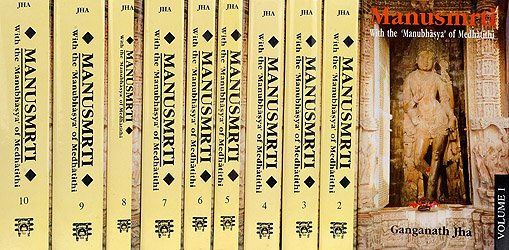Manusmriti with the Commentary of Medhatithi
by Ganganatha Jha | 1920 | 1,381,940 words | ISBN-10: 8120811550 | ISBN-13: 9788120811553
This is the English translation of the Manusmriti, which is a collection of Sanskrit verses dealing with ‘Dharma’, a collective name for human purpose, their duties and the law. Various topics will be dealt with, but this volume of the series includes 12 discourses (adhyaya). The commentary on this text by Medhatithi elaborately explains various t...
Verse 7.187
Sanskrit text, Unicode transliteration and English translation by Ganganath Jha:
दण्डव्यूहेन तन् मार्गं यायात् तु शकटेन वा ।
वराहमकराभ्यां वा सूच्या वा गरुडेन वा ॥ १८७ ॥daṇḍavyūhena tan mārgaṃ yāyāt tu śakaṭena vā |
varāhamakarābhyāṃ vā sūcyā vā garuḍena vā || 187 ||He shall march on this road arraying his army in the form of a staff, or in that of a cart, or a boar, or an alligator, or a needle or the Garuḍa-bird.—(187)
Medhātithi’s commentary (manubhāṣya):
When the army is arranged in the shape of a staff, it is said to be ‘arrayed in the form of a staff’; similarly when in the shape of the cart, it is ‘arrayed in the form of a cart’; and so on with the rest.
(A) In the fore-front, there is the Commander of the entire force,—then the king in the centre,—then the army-commander,—on his two flinks, the elephants,—close to them the horses,—then the footsoldiers; the whole of this army being, like the staff and operating in a straight line.
(B) Operating on both sides is the ‘needle-array’, in which the soldiers operate in a solid mass, the bravest being in the forefront; it constitutes a very much-lengthened line, all operating simultaneously.
(C) The ‘alligator-array’ is broad at the front face and at the two flanks (thighs), and highly recommended; as nowhere in this array is there any weak point; and even when pressed by braver enemies, it leads to the breaking up of the enemy’s forces; and in the end its purpose is entirely and surely accomplished. The rest of the army is to be thrown into the middle of the array.
The above-mentioned dispositions of the army ore to by resorted to in accordance with the end in view; on even ground the advance should be made either in the ‘staff’ or the ‘needle’ or the ‘garuḍa’ array; but on uneven ground, and on ground beset with obstructions, etc. that of the ‘cart’ or the ‘alligator’ or the ‘boar’.—(187)
Explanatory notes by Ganganath Jha
See Kāmandaka, 19, for the various kinds of tactical disposition of the forces.
This verse is quoted in Parāśaramādhava (Ācāra, p. 401);—in Vīramitrodaya (Rājanīti, p. 400), which adds that full descriptions of the several Vyūhas the reader will find in Lakṣaṇaprakāśa;—and in Rājanītiratnākara (p. 26a).
Comparative notes by various authors
Śukranīti (4.7.551 et seq.).—‘The Krauñca- array is formed according to the nature of the ground and consists in arranging the troops in rows resembling the rows of birds flying in the sky; it is that order in which the neck is thin, the tail medium and the wings thick. The Śyena -array is that in which the wings are large, the neck and tail medium, and the mouth small. The Makara -array is that which has four legs, long and thick mouth and two lips. The Sūcī- array has a thin mouth and a hole at the back and resembles a rod.—The Chakra- array has eight concentric circles facing all directions and one passage. The Sarvatobhadra -array is the order having eight sides in all directions. The Ratha -array has the aspect of a cart, and the Sarpa -array, that of a snake.’
Kāmandaka (18.49).—‘When there would be danger in the rear, the Chariot-array should be formed; when it would he in the flanks, then the Vajra -array; and in all situations the Sarvatobhadra -array should be formed, which frightens the enemy.’
